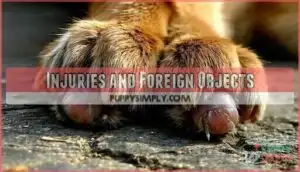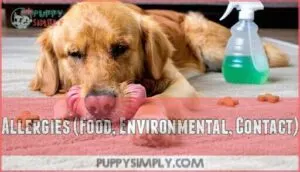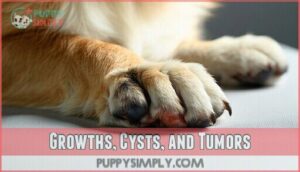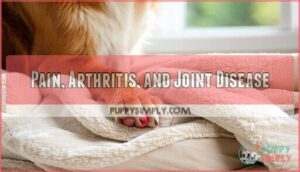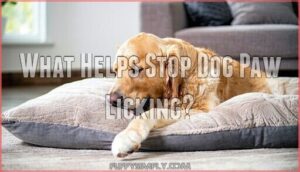This site is supported by our readers. We may earn a commission, at no cost to you, if you purchase through links.

This kind of excessive behavior could point to anything from a pesky thorn to allergies, infections, or even stress. Figuring out the cause can be tough because dogs can’t exactly tell us what’s wrong or where they hurt.
Some dogs lick because environmental allergens make their paws itchy, while others do it as a way to deal with stress or relieve boredom. Injuries and infections might also lead to non-stop licking, which can worsen the original problem.
Recognizing the difference between normal grooming and a potential issue lets you know when it’s time to intervene and get your dog the medical attention it needs.
Table Of Contents
Key Takeaways
- Excessive paw licking goes beyond normal grooming and can signal underlying issues like allergies (affecting up to 85% of cases), infections, injuries, or behavioral problems such as anxiety and boredom.
- Physical causes dominate paw licking cases, with bacterial infections present in 41% of pododermatitis cases and yeast overgrowth common in moist paw folds, especially in breeds like Boxers and German Shepherds.
- Diagnosis requires a systematic veterinary approach including physical exams, diagnostic tests (bloodwork, imaging, skin cytology), and behavioral evaluation to identify whether the cause is medical or psychological.
- Treatment must address the root cause through medications (topical corticosteroids, antibiotics, antifungals), dietary changes for food allergies, behavioral modification for anxiety-driven licking, and preventive care like regular paw checks and moisturizing.
Why Do Dogs Lick Their Paws?
You might notice your dog licking their paws from time to time, and that’s usually nothing to worry about.
But when the licking becomes constant or intense, it’s worth paying attention to what’s going on. Let’s look at the difference between normal grooming and the kind of licking that signals something needs your help.
Normal Vs. Excessive Licking
You’ve probably noticed your dog licking their paws after a walk or meal—that’s just normal grooming.
But if you’re seeing the same paw get licked over and over, sometimes until the fur looks different or the skin’s red, that’s when it crosses into problem territory.
Watch for these signs:
- Licking frequency increases – Your dog licks for several minutes at a time or returns to the same paw constantly
- Behavioral triggers emerge – Licking starts when your dog feels anxious, bored, or stressed
- Physical changes appear – You notice redness, hair loss, or moist skin on the paws
- Underlying causes develop – Pain, allergies, or infections drive the behavior beyond normal grooming
The key is how often and how intensely your dog licks. Some breeds are more prone to this behavior, but if any dog keeps going at their paws, you’ll want to figure out why—before the licking causes bigger issues.
Affection and Attention-Seeking
Sometimes, though, your dog isn’t licking their paws because something hurts—they’re simply trying to tell you they’d like a little extra love or playtime. Dogs use licking as a bonding behavior, and if you’ve responded with attention before, they’ve learned that association. This attention-seeking becomes a reward cycle where owner interaction reinforces the habit.
| Behavior Type | What It Looks Like |
|---|---|
| Seeking Connection | Your dog licks paws while watching you, stops when you approach |
| Learned Association | Licking starts when you’re busy, ends when you engage |
| Attention Reward | You pet or talk to them during licking episodes |
| Bonding Behavior | Licking happens often during quiet together-time |
While affection-driven licking differs from anxiety or behavioral issues, it can still become excessive if unintentionally encouraged.
Signs of a Problem
- Persistent licking that happens multiple times daily or lasts longer than a few minutes at a time
- Skin changes like redness, inflammation, hair loss, swelling, or open sores on the paws
- Behavioral shifts including limping, reluctance to walk, increased anxiety, or obsessive focus on one paw
What Health Issues Cause Paw Licking?
If your dog keeps licking its paws, there’s usually a physical cause behind it. Health issues top the list—ranging from simple irritants to conditions that need a vet’s attention.
So what specific medical problems might be driving this behavior?
Injuries and Foreign Objects
Even if your dog’s paw seems okay, constant licking could point to a hidden cut, a tiny splinter, or a sharp seed. Check between their pads and toes for swelling, embedded thorns, or any cuts.
Hot pavement might cause burns, and winter brings the risk of frostbite. If you’re unable to safely remove a splinter or notice limping and redness, get in touch with your vet immediately.
Allergies (Food, Environmental, Contact)
Allergies are a major reason why dogs constantly lick their paws. Food allergies—often from beef, dairy, or chicken—affect up to 15% of dogs with skin problems. Environmental factors like dust mites and pollen cause itching in over 85% of allergy cases. Fleas or mites are also a frequent culprit, triggering allergic reactions and itching.
- Food allergens can cause reactions in months, so elimination diets are key for diagnosis
- Environmental allergies often get worse indoors, impacting paw hydration and causing redness between toes
- Contact dermatitis from grass or cleaning products affects areas that touch surfaces directly
- Allergy testing with your vet identifies triggers and guides effective treatment
Contact allergies are less prevalent and usually clear up quickly once you avoid what’s causing them.
Infections (Bacterial, Fungal, Yeast)
When bacteria, yeast, or fungi get between your dog’s toes, the discomfort can cause constant licking. Bacterial dermatitis is present in nearly 41% of pododermatitis cases; bacterial infections are therefore the most common infectious cause.
Yeast overgrowth—usually Malassezia—does well in moist paw folds, particularly in breeds like Boxers and German Shepherds. Fungal infections show up in about 5% of skin cases and are more common in younger dogs.
Allergies often cause dog paw yeast infections. Treatment costs have increased 7.6% recently, but getting care quickly helps prevent complications and improves how infections turn out.
Growths, Cysts, and Tumors
If you notice any lumps, bumps, or unusual swelling on your dog’s paws, expect them to lick the area constantly. These growths or tumors—whether harmless cysts or dangerous melanomas—cause discomfort depending on where they’re located.
Cysts that develop between the toes can be especially bothersome. A vet visit is essential to identify the type of growth and discuss options for removing cysts.
If your dog keeps licking their paw, it’s usually a sign that something is wrong and needs a vet’s attention.
Pain, Arthritis, and Joint Disease
If your dog has chronic pain from arthritis or joint disease, they might obsessively lick their paw. Dogs often lick the painful area to try and soothe themselves when joint pain or inflammation flares up. Watch out for these issues:
- Degenerative joint disease causing persistent discomfort
- Soft tissue injuries around the paw or leg
- Arthritis making movement painful
- Joint issues worsening with age or activity
- Pain medication trials helping confirm the diagnosis
Your vet can evaluate the joint pain and suggest options for arthritis pain relief to address these types of joint problems.
Can Stress or Behavior Lead to Licking?
Not all paw licking stems from physical problems—sometimes what’s happening in your dog’s mind plays just as big a role. Stress, boredom, and compulsive tendencies can all trigger this behavior, turning licking into a coping mechanism or habit.
So what drives this from a psychological angle? Behavioral factors often explain why some dogs lick their paws excessively.
Anxiety and Stress
Just like you might bite your nails when nervous, your dog may turn to their paws for comfort. Anxiety and stress in dogs—whether from loud noises, separation anxiety, or unfamiliar situations—can trigger compulsive licking as a self-soothing mechanism.
When dogs feel anxious or stressed, they often lick their paws repeatedly as a way to self-soothe, much like humans bite their nails
Around 16% of dogs show compulsive behavior, with anxiety as a major driver. This repetitive action temporarily calms them but can escalate into a harmful habit, causing skin damage and infections. Behavioral therapies and medication options can help break this cycle.
Boredom and Loneliness
If your dog is alone for hours with nothing to do, licking their paws can become their go-to activity—a way to entertain themselves when they’re not getting enough stimulation. Boredom combined with loneliness leads to behavioral issues that resemble anxiety and stress in dogs.
Try these solutions:
- Enrichment activities like puzzle toys and treat-dispensing games
- Social interaction through doggy daycare or playdates
- Mental stimulation via training sessions and scent work
- Routine changes that break monotony and prevent separation anxiety
Often, the answer to behavioral problems is simply to engage with your dog more.
Compulsive Behaviors and Learned Habits
Sometimes, a simple lick can become an unconscious habit for your dog, much like nail biting in people. This can escalate into a compulsive behavior that’s difficult to stop.
These behaviors happen when your dog is unable to do what they want, so they lick as a way to calm down. If they learned early on that licking gets them attention, that can also reinforce the habit.
Providing a stimulating environment and using behavior modification techniques can help stop these behaviors before they become obsessive and require treatment.
How is Excessive Paw Licking Diagnosed?
If your dog keeps licking its paws, your vet becomes a detective—piecing together clues to crack the case.
So what’s their process for getting to the root of it?
Clinical History and Physical Exam
Your vet will begin by asking detailed questions about the start of the licking, how often it occurs, and if your dog is showing other signs like limping or scratching. This initial discussion is useful to narrow down possible causes.
Then they’ll perform a hands-on exam to check for:
- Injuries or foreign objects stuck between toes or paw pads
- Skin conditions like redness, swelling, or signs of allergy
- Pain responses during palpation findings that suggest arthritis or joint issues
Visually assessing licking patterns will inform your veterinary care.
Diagnostic Tests (Bloodwork, Imaging, Skin Tests)
Once the physical exam is complete, your vet will likely run a few tests to pinpoint what’s causing the excessive licking. Blood tests can reveal infections, inflammation, or hormone issues that might be at play. X-rays or ultrasounds help spot problems like arthritis, hidden foreign objects, or even tumors.
Skin samples and scrapings are key for catching bacterial, fungal, or parasitic culprits—think mites or yeast overgrowth. If allergies seem likely, your vet might suggest intradermal or blood testing to identify environmental triggers behind the behavior.
| Test Type | What It Reveals |
|---|---|
| Bloodwork | Infection, inflammation, hormonal imbalances |
| Imaging (X-ray, ultrasound) | Joint disease, foreign objects, tumors |
| Skin tests (cytology, scrapings) | Bacteria, yeast, mites, fungal infections |
Behavioral Evaluation
If tests can’t find a medical reason, a behavior assessment can help figure out if the licking stems from anxiety, boredom, or something compulsive.
A veterinary behaviorist will look at your dog’s history, what sets them off, their environment, and how you interact with them. They’ll judge how severe the compulsion is and suggest ways to help, including behavior changes to manage these issues.
What Helps Stop Dog Paw Licking?
To stop your dog from licking its paws, you need to treat the underlying cause. Your veterinarian will suggest treatments based on their diagnosis, such as medication, changes to your dog’s routine, or a combination.
Here are some common ways to help:
Medical Treatments and Medications
Once your vet identifies the cause, treatment can begin. Medications will depend on the diagnosis, but the goal is to break the itch-scratch-lick cycle and repair skin damage. Common treatments include:
- Topical corticosteroids like hydrocortisone rapidly decrease inflammation but require limited use to prevent side effects
- Systemic antibiotics (often potentiated penicillins or cephalosporins) treat bacterial infections, usually for several weeks
- Antifungal therapy addresses yeast with medicated shampoos, wipes, or creams applied directly to paws
- Immunosuppressive drugs such as Apoquel or Atopica manage chronic allergic licking with daily doses
- Anti-inflammatory medications and antibacterial/antifungal medications often work together for stubborn cases
For compulsive licking, SSRIs or behavioral-modifying medication may be beneficial if environmental enrichment isn’t enough.
Addressing Allergies and Infections
Allergies and infections won’t clear up without intervention, so getting the right treatment is key to breaking the cycle and making your dog comfortable again.
If it’s a food allergy, your vet might suggest an elimination diet to find out what’s causing it. Environmental allergies often need testing, followed by either immunotherapy or medicines to control the reaction.
Skin infections, whether bacterial or fungal, require antibiotics, either topical or oral, to prevent secondary problems from arising.
Behavioral Modification and Enrichment
If licking stems from stress, anxiety, or boredom, a change of scenery and schedule can be surprisingly effective. Behavior modification uses habit reversal along with training to interrupt the licking as soon as it begins.
Boost mental engagement with puzzle toys, scent games, and daily walks—this kind of stimulation keeps a dog occupied.
Altering the environment, such as by creating a quiet retreat or increasing playtime, gets to the bottom of behavioral issues and provides practical behavioral remedies.
Preventive Care and Home Management
Keeping your dog’s paws in good shape doesn’t have to be hard. Regular paw care means checking between their toes for dirt, clipping their nails every few weeks, and putting paw balm or coconut oil on to keep harsh surfaces from hurting them.
What they eat affects their skin, and keeping things clean—like wiping their paws after walks—keeps allergens away.
Spotting problems early by checking their paws often, along with making sure they get enough exercise, lets you take care of things before they become habits.
Frequently Asked Questions (FAQs)
How can I tell if my dog’s paw licking is normal or excessive?
It’s normal for dogs to groom themselves by licking their paws, but be alert for warning signs like constant licking, redness, hair loss, or limping.
If you see excessive paw licking along with itching or skin problems, it’s a sign that something is wrong and needs veterinary care.
Can dry air cause paw licking?
It might seem odd, but dry air isn’t a direct trigger for dogs licking their paws; however, it does make the problem more likely.
Paw licking in the winter frequently starts as indoor air gets drier, which leads to skin dryness and static. These kinds of environmental conditions can irritate the skin and cause itching, encouraging dogs to lick at paws for comfort.
When dryness is the reason, paw licking tends to get better with moisturizers and humidifiers.
Are certain breeds more prone to licking?
Yes, certain breeds face higher risks for dog behavior problems and dog health problems that trigger paw licking.
Genetics play a significant role here—dogs with skin folds or allergy-prone breeds tend to lick their paws more often. Certain breeds also carry anxiety traits or body structures that make them more likely to develop this habit.
How long until treatment reduces paw licking?
Treatment timelines can vary quite a bit. Ironically, you’ll need patience more than anything when your dog just keeps licking.
How long medication is needed and when behaviors change depends on what’s causing it. Constant paw licking due to allergies might get better in days or weeks if you treat it correctly, but compulsive behaviors need a longer treatment plan and a long view.
Can diet changes help stop paw licking?
Paw licking in dogs can definitely be caused by food sensitivities. A novel protein elimination diet can pinpoint problematic ingredients.
Hypoallergenic diets foster a healthier gut microbiome and lessen food allergies, frequently breaking the itch-lick cycle completely if the ingredients are high quality.
When should you use an e-collar?
Funnily enough, the tool designed to prevent injury proves most effective when used for a short time. If your dog develops lick granuloma or keeps licking excessively despite behavior changes, use an e-collar.
It helps prevent complications while medication takes effect, but monitored use is key—gradually stop using it once healing starts.
Conclusion
If your dog keeps licking its paws, it’s like a signal that something’s off. It could be allergies making their feet itchy, a hidden injury, or even pent-up stress.
Dealing with excessive paw licking early on can prevent bigger issues later. A vet visit can figure out what’s causing it and help your dog feel better, which saves you both from stress and discomfort.
- https://www.dvm360.com/view/skin-allergies-rank-among-rank-among-the-most-common-conditions-in-dogs-and-cats-pet-insurance-data-shows
- https://apnews.com/article/pet-allergies-vet-cat-dog-3280469c97303bb75965c740512b1e21
- https://bestfriends.org/pet-care-resources/why-my-dog-licking-his-paws-so-much-causes-and-remedies
- https://thepetlabco.com/learn/dog/behavior/why-do-dogs-lick-their-paws
- https://www.akc.org/expert-advice/health/pododermatitis-in-dogs/

